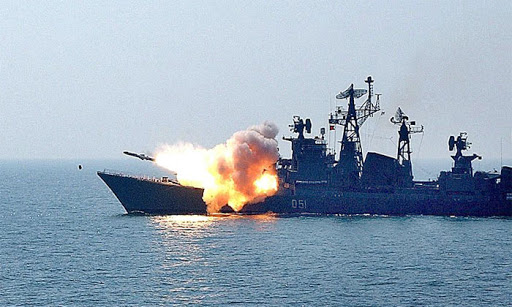Aircraft carriers play a very important role as a force equalizers and if India wants to maintain the edge over China in its own backyard, aircraft carriers will give her the strength to stand firm against the inequitable behaviour of China.
By Balaji Subramanian
The Indian Navy is still very keen on acquiring a third aircraft carrier and two new fighter squadrons to counter the ever-expanding footprint and machinations of China in the Ocean Region (IOR).
Due to the spread of the Covid-19 pandemic, the much-needed commissioning of India’s second aircraft carrier has been delayed till September next year.
The first indigenous aircraft carrier (IAC-I) being built at the Cochin Shipyard’s “basin trials” have been delayed by the pandemic.
INS Vikrant basin trials would have checked the 40,000-tonne warship propulsion, transmission and shafting systems.
In 2003, the government had approved the basin trials of IAC-I, followed by extensive sea trials. Now IAC-I will get commissioned in September 202, and then the “flight trials” will be conducted to make the carrier fully operational by 2022-2023.
Aircraft carriers have been playing an important role since the Second World War because nothing projects raw combat power like an aircraft carrier strike group (CSG) that the US recently displayed in the South China Sea.
These massive floating airports are a force multiplier and as China has plans to operate more aircraft carriers, India is keen not to lose the edge when it comes to operating carrier battle groups.
The nuclear-powered aircraft carriers operated by the US navy are capable of moving over 500 nautical miles (900 km) in a single day, which helps in deploying them for any operations at a moments notice. At present, the United States Navy has 11 nuclear-powered fleet carriers—carrying around 80 fighter jets each.
The need for aircraft carriers for the Indian navy is very urgent because China is already operating two aircraft carriers, although they lack the operational experience and there are serious doubts about their capabilities.
At present, the Peoples Republic Army Navy (PLAN) has two combat-ready aircraft carriers, the Liaoning and Shandong, with the third under construction with plans for nuclear propulsion.
In theory, a nuclear-powered aircraft carrier could be at sea for twenty-five years or longer because it does not need any refuelling, and if China operates nuclear-powered aircraft carrier, it will be a giant leap to become a blue-water navy and it could also have an expeditionary force.
China with its vast economic powers at a feverish pace is constructing two more aircraft carriers and have plans to have 10-carrier Navy by 2050.
The recent freedom navigation patrols by the American navy was seen by China as an act of intimidation which also brought out in the open the “Malacca Dilemma”.
The phrase, the Malacca Dilemma was coined by former president Hu Jintao in 2003. In 2017, China became the world’s largest oil importer, surpassing the US. Approximately 80 per cent of the country’s oil requirements have to come through the Malacca Stright.
China gets its oil from the Middle East and its oil tankers have to pass through the Strait of Malacca, a narrow stretch of water between the Indonesian island of Sumatra and the Malay Peninsula.
If China avoids Malacca Stright which is a shortcut, it would have to use the Lombok and Makassar Straits. But this change in route will come with a cost and according to S. Rajaratnam School of International Studies (RSIS), China will incur additional shipping costs estimated to be around $84 to $220 billion per year.
This is a natural strategic chokepoint which the Indian navy along with the US and other nations can implement. However, such a scenario would only happen in reality if there is a serious escalation of tension.
Right now India operated its only aircraft carrier, the 44,500-tonne INS Vikramaditya, the refurbished Admiral Gorshkov inducted from Russia for $2.33 billion in November 2013.
INS Vikramaditya operates the MiG-29K from its flight decks and some of these fighters have been deployed in the Eastern sector of Ladakh.
Right now the Navy wants the “acceptance of necessity (AoN)” for a third carrier, the 65,000-tonne IAC-II (tentatively christened INS Vishal), pending since May 2015.
As China plans to build a nuclear-powered aircraft carrier, India has dropped the idea of nuclear-propulsion for IAC-II due scales of economy. The Navy now has plans to build the carrier at a projected cost of Rs 45,000 crore.
Modi government has fast-tracked several key defence procurements in light of the growing tension with China. Also, the prospect of a two-front war with Pakistan and China have strong possibilities.
That is why there is a strong possibility that the proposal could have smooth sailing and the government fast-tracking some long-pending defence projects due to the military confrontation with China.
The Navy has also cut down its requirement of 57 multi-role fighters capable of operating from carriers to about 36 (two squadrons) now. The contenders for supplying the multi-role fighters are the about to operationalised French Rafale, American F/A-18, Swedish Gripen and Russian MiG-29K which the navy already operates.
From a political and operational perspective, the Russian MiG-29 K could be chosen since the navy has years of operational experience.
If India chooses the French Rafale it would get its hands on a 4-plus generation fighter in its armoury and we will also have a lot of experience flying these plans. Indian navy pilots often fly combat sorties for the Indian Air Force (IAF) when there is a need to bolster squadron strength.
America for a long time have been trying to sell India its fighters and the BoeingF/A-18 are twin-engine, carrier-capable, multirole fighter aircraft with years of operational experience. However, if India chooses the American fighter, there will be a serious problem with interoperability of weapon system.
India is also trying to induct its indigenous twin-engine naval fighter but it is likely to be ready only by 2032 and twelve years is a long wait in the interest of national security.
India does enjoy one significant advantage over China because we have mastered the intricate art of operating aircraft carriers for six decades. The first aircraft carrier INS Vikrant was commissioned with its Sea Hawk jets operating from its flight deck playing one of the most crucial roles in the 1971 war against Pakistan.
Aircraft carriers play a very important role as a force equalizers and if India wants to maintain the edge over China in its own backyard, aircraft carriers will give her the strength to stand firm against the inequitable behaviour of China.
Balaji Subramanian is a freelance writer who writes in the field of mental health, music and politics. He tweets @LaxmanShriram78












